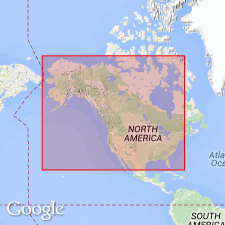
- Usage in publication:
-
- Hawthorne beds*
- Modifications:
-
- Original reference
- Dominant lithology:
-
- Oolite
- Sandstone
- Gravel
- Sand
- Clay
- AAPG geologic province:
-
- Florida platform
Summary:
Pg. 81-82, 107-112, 157, 158, 326. Hawthorne beds of Chattahoochee group. Beds of phosphatic rock, more or less broken up and enclosed in a younger matrix, overlying Vicksburg limestone at "Devil's Millhopper," near Gainesville, [approx. Lat. 29 deg. 42 min. 30 sec. N., Long. 82 deg. 22 min. 45 sec. W., Devils Mill Hopper State Geological Site, Gainesville West 7.5-min quadrangle, Alachua County, Florida], and occurring as remnants in place near Archer, Arredondo, and other places. Includes (descending) phosphatic oolite, soft sandstone, ferruginous gravel, sand, or sandstone, and greenish yellow clays. Rests on Nummulitic beds of Vicksburg group. Underlies Altamaha grit. Maximum thickness 125 feet. Included in Chattahoochee group. [Age is early Miocene.]
[Named from exposures at Hawthorn, Alachua Co., FL.]
Source: US geologic names lexicon (USGS Bull. 896, p. 926-927).

- Usage in publication:
-
- Hawthorn formation*
- Modifications:
-
- Overview
- AAPG geologic province:
-
- Atlantic Coast basin
- Florida platform
- South Georgia sedimentary province
Summary:
Hawthorn formation of Alum Bluff group. Later work [post-1892] by G.C. Matson (USGS Bull. 604, p. 13, 1915) led him to believe these beds were same as Alum Bluff, the better-established name, and Hawthorn formation was therefore abandoned. Later work by Julia Gardner led her to opinion (1925) that Hawthorn formation was = only basal part (Chipola formation) of Alum Bluff group, and the name still remained abandoned. In 1929 (Florida Geol. Survey 20th Ann. Rpt.), however, C.W. Cooke and S. Mossom revived Hawthorn formation as designation of a lithologic unit (chiefly phosphatic limestone and fullers earth) within Alum Bluff group (of lower and middle Miocene age), and chiefly if not wholly = Chipola formation (of different lithology) of Alum Bluff group, but which may include a representative of Oak Grove sand. As redefined by Cooke and Mossom the Hawthorn formation includes the original Hawthorn "beds" of Dall, but excludes the CASSIDULUS-bearing limestone and chert that Matson and Clapp [Florida Geol. Survey 2nd Ann. Rpt., p. 69-74, 1909] placed in Hawthorn formation but which is now known to be Tampa. With it tentatively included Dall's Jacksonville limestone and Manatee River marl, which it has been found impracticable to map seperately, although their faunas seem to be younger than that of typical Hawthorn. Dall's Sopchoppy limestone, of Chipola age, is also placed in Hawthorn formation. According to T.W. Vaughan and Julia Gardner the †Jacksonville formation is of [late] Miocene age, and younger than any part of Alum Bluff group. The typical Hawthorn formation is considered by Gardner, Cooke and Mossom to be of Chipola ([early] Miocene) age.
Named from exposures at Hawthorn, Alachua Co., FL. Recognized in central northern, northern and southern FL, southern and southeastern GA, and SC.
Source: US geologic names lexicon (USGS Bull. 896, p. 926-927).
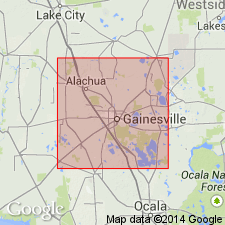
- Usage in publication:
-
- Hawthorn formation
- Modifications:
-
- Areal extent
- AAPG geologic province:
-
- Florida platform
Summary:
The type locality of the Hawthorn formation is in SW/4 NE/4 sec. 31, T. 10 S., R. 22 E., Alachua Co., FL.
Source: GNU records (USGS DDS-6; Reston GNULEX).
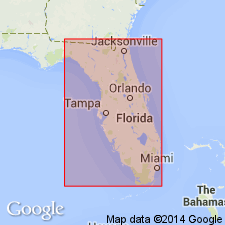
- Usage in publication:
-
- Hawthorn Group
- Modifications:
-
- Revised
- AAPG geologic province:
-
- Florida platform
- South Georgia sedimentary province
Summary:
The Hawthorn Group is present in all of peninsular FL except the Ocala upland and Sanford high and is subdivided into the (ascending) Arcadia Formation (Miocene), Noralyn Formation (Miocene), and Bone Valley Formation (Pliocene). The Hawthorn is wedge shaped and ranges in thickness from a feather edge to more than 700 ft in the Okeechobee Basin. Since the Hawthorn is raised to Group rank, it ranges in age from Miocene to Pliocene.
Source: GNU records (USGS DDS-6; Reston GNULEX).
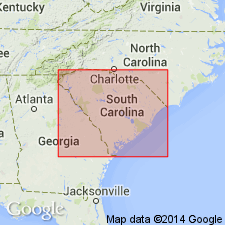
- Usage in publication:
-
- Hawthorn Group
- Modifications:
-
- Areal extent
- AAPG geologic province:
-
- Atlantic Coast basin
Summary:
In South Carolina, the Hawthorn Group consists of the Parachucla, Marks Head, and Coosawhatchie Formations.
Source: GNU records (USGS DDS-6; Reston GNULEX).

- Usage in publication:
-
- Hawthorn Group
- Modifications:
-
- Revised
- AAPG geologic province:
-
- Florida platform
- South Georgia sedimentary province
Summary:
The Hawthorn is raised to Group status in FL. It is composed in northern FL of the (ascending) Penney Farms, Marks Head, Coosawhatchie, and Statenville Formations. In central and southern FL the Hawthorn Group is composed of the (ascending) Arcadia (Nocatee and Tampa Members) and Peace River (Bone Valley Member) Formations.
Source: GNU records (USGS DDS-6; Reston GNULEX).
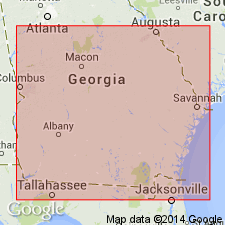
- Usage in publication:
-
- Hawthorne Group
- Modifications:
-
- Principal reference
- AAPG geologic province:
-
- Atlantic Coast basin
- Florida platform
- South Georgia sedimentary province
Summary:
The Hawthorne is retained for use in GA at group rank, in preference to the adjacent Alum Bluff of western FL. Other names that have been used for all or parts of the Hawthorne in GA but are no longer applicable or useful include Combahee, Duplin Marl, and Chipola. A hypostratotype is designated in the bluffs along the Savannah River from Tiger Leap Bluff in Screven Co., to Old Wood Landing in central Effingham Co. The neostratotype is designated as the Florida type locality after Pirkle (1956) in SW1/4NE1/4, sec. 31, T10S, R22E, Alachua Co., FL. The Hawthorne Group in Georgia is divided into five named formations, which include nine named members, and one unnamed formation. Ascending, these are the Parachucla Formation (with its Tiger Leap and Porters Landing Members (new names)); the Torreya Formation (with its Dogtown (new name) and Sopchoppy Members), and the laterally equivalent Marks Head Formation; the Coosawhatchie Formation (including the Meigs, Ebenezer, Berryville Clay, Tybee Phosphorite Members (all new names), and the Charlton Member), and the laterally equivalent Statenville Formation (new name). The unnamed formation is a lower Miocene dolostone, clay, and sand of south-central GA and northern peninsular FL. The time span of the Hawthorne in GA is from earliest Miocene (early Aquitanian) through the early Pliocene (Zanclean).
Source: GNU records (USGS DDS-6; Reston GNULEX).
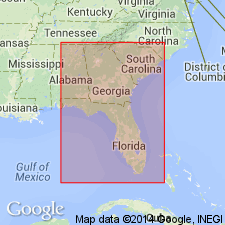
- Usage in publication:
-
- Hawthorn Formation
- Modifications:
-
- Revised
- AAPG geologic province:
-
- Florida platform
Summary:
Uppermost member of Hawthorn Formation, which has previously remained unnamed, is here referred to as Sarasota Member. New unit is typically a yellow-tan calcareous clay. Contains large percentage of phosphorite pebbles and granules and abundant phosphatized bone fragments, mainly from large marine mammals. Shark teeth common. Differs from lower members of Hawthorn in that they contain no macrofossils. In addition to type section, unit is exposed at depth of 10 to 20 m in several small quarries along I-75 south of Venice. Thickness from core data estimated at over 20 m. Unconformably underlies early Pliocene Buckingham Formation. Sarasota is correlated on the basis of fossils with Eastover Formation (MD,VA). Age of Sarasota is late Tortonian and early Messinian (late Miocene).
Source: GNU records (USGS DDS-6; Reston GNULEX).
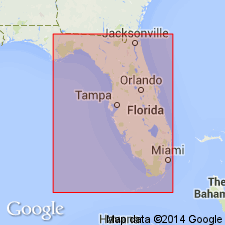
- Usage in publication:
-
- Hawthorn Group
- Modifications:
-
- Revised
- AAPG geologic province:
-
- Florida platform
- South Georgia sedimentary province
Summary:
The formations of the Hawthorn Group recognized in southern GA by Huddlestun (1988) are extended to northern FL. In southern Florida, the group consists of the Arcadia Formation (reinstated) and the Peace River Formation (new). In the panhandle, it consists of the Torreya Formation and, in some areas, an unnamed siliciclastic unit. Age of the Hawthorn in northern FL is early Miocene (Aquitanian) to middle Miocene (Serravallian), while in southern FL it is early Miocene (Aquitanian) to early Pliocene (Zanclean).
Source: GNU records (USGS DDS-6; Reston GNULEX).
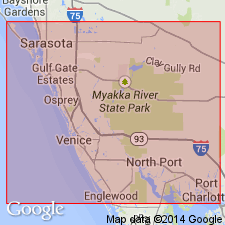
- Usage in publication:
-
- Hawthorn Group
- Modifications:
-
- Revised
- AAPG geologic province:
-
- Florida platform
Summary:
Sarasota Member of Petuch (1988) not used. Unit is called Bed 11 after Petuch (1982) and is removed from the Hawthorn and reestablished as part of the Tamiami. An early Pliocene age is assigned to Bed 11.
Source: GNU records (USGS DDS-6; Reston GNULEX).
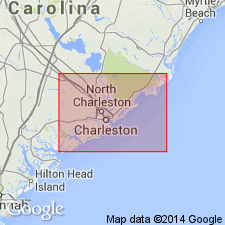
- Usage in publication:
-
- Hawthorn Formation*
- Modifications:
-
- Revised
- Areal extent
- Not used
- AAPG geologic province:
-
- Atlantic Coast basin
Summary:
The Coosawhatchie Clay Member of the Hawthorn Formation is revised to include underlying or laterally detached sand beds of the same age in SC and is raised to formation status as the Coosawhatchie Formation. Because of the paucity of dolomite in beds equivalent to the type Hawthorn of FL, the name Hawthorn probably should not be used in SC.
Source: GNU records (USGS DDS-6; Reston GNULEX).
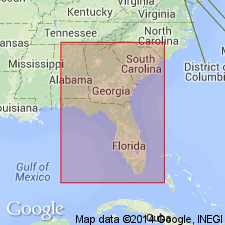
- Usage in publication:
-
- Hawthorn Group*
- Modifications:
-
- Areal extent
- AAPG geologic province:
-
- Florida platform
- South Georgia sedimentary province
Summary:
Following Huddlestun (1982), the Hawthorn Group in GA includes the Parachucla Formation (Aquitanian), Marks Head Formation (Burdigalian) and its equivalent Torreya Formation in the hFlorida Panhandle, and the Coosawhatchie Formation (Langhian and Serravallian). The Hawthorn group in GA also includes the Wabasso Formation (Pliocene, Zanclean). In central FL, the Hawthorn Group is divided into the Arcadia, Peace River (Noralyn) and Bone Valley Formations. The lower and upper Hawthorn Group represents high sea-level stands while the middle part represents a period of low sea level (relative to present sea level).
Source: GNU records (USGS DDS-6; Reston GNULEX).
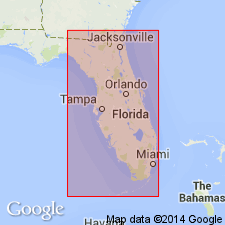
- Usage in publication:
-
- Hawthorn Formation*
- Hawthorn Group*
- Modifications:
-
- Areal extent
- AAPG geologic province:
-
- Florida platform
- South Georgia sedimentary province
Summary:
Table 2 shows the Miocene through Holocene stratigraphy of FL. In the Land-pebble district and Southern extension of central FL, the Hawthorn Formation underlies the Bone Valley Formation or Tamiami Formation. For Southern FL, the Hawthorn Group is shown to include the Arcadia Formation (and its Nocatee and Tampa Members) and the Peace River Formation (and its Bone Valley Member).
Source: GNU records (USGS DDS-6; Reston GNULEX).
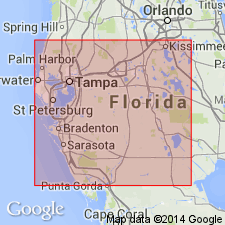
- Usage in publication:
-
- Hawthorn Group*
- Modifications:
-
- Areal extent
- AAPG geologic province:
-
- Florida platform
Summary:
Authors accept the usage of Scott (1988) for the Hawthorn Group in FL. The Hawthorn Group consists of (ascending) the Arcadia Formation and its Tampa Member (Miocene), Peace River Formation (Miocene), and Bone Valley Formation (Miocene and Pliocene). The Pliocene part of the Bone Valley Formation correlates with the Tamiami Formation in the southern extension of the Land-pebble district.
Source: GNU records (USGS DDS-6; Reston GNULEX).
- Usage in publication:
-
- Hawthorn Formation
- Hawthorn Group
- Modifications:
-
- Overview
- AAPG geologic province:
-
- Atlantic Coast basin
- Florida platform
- South Georgia sedimentary province
GNU Staff, 1991, GNU Staff remark on the Hawthorn Group.: U.S. Geological Survey Digital Data Series, DDS-6, 1 CD-ROM., release 3
Summary:
The name of the town used for the Hawthorn Formation/Group changed its name to Hawthorne in 1948 (U.S. Board on Geographic Names). Several authors over the years have used the name Hawthorne (with the "e") for the formation/group. However, usage has remained with the original spelling.
Source: GNU records (USGS DDS-6; Reston GNULEX).
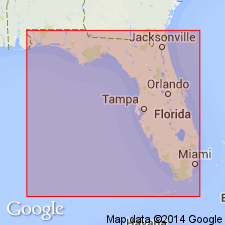
- Usage in publication:
-
- Hawthorn Formation
- Modifications:
-
- Revised
- AAPG geologic province:
-
- Florida platform
Summary:
Author states that it is not clear how Petuch's (1988) Sarasota Member of the Hawthorn Formation differs faunistically from Hunter's (1968) Murdock Station Member of the Tamiami Formation. On the basis of the species Petuch (1982) listed in Unit 11 (now designated Sarasota Member), the unit might be assigned an early Pliocene age. Because of uncertainties in the relationship between these units, author continues to refer strata to the Tamiami, though Vokes (1988) preferred to call them Pinecrest beds. Sarasota Member of the Hawthorn not used.
Source: GNU records (USGS DDS-6; Reston GNULEX).
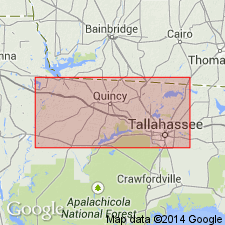
- Usage in publication:
-
- Hawthorn Group
- Modifications:
-
- Biostratigraphic dating
- AAPG geologic province:
-
- Florida platform
Summary:
New data supports the view that the Alum Bluff and Hawthorn Groups are relatively contemporaneous. The Dogtown Member of the upper Torreya Formation of Hawthorn Group in northern Gadsden Co., FL, contains an early Barstovian land mammal fauna and has 87Sr/86Sr age estimates between 16.6+/-1.0 and 14.7+/-1.5 Ma. These, together with reversed magnetic polarity constrain the age of the Dogtown in the study area to between 15.9 and 15.3 Ma. Evidence from a second fossil locality indicates that the Dogtown is time transgressive--younger to the north. Age of the Torreya is constrained to late early to early middle Miocene (19 to 15.3 Ma). The Chipola Formation of the Alum Bluff Group, which interfingers with the Torreya at Alum Bluff, is largely older than the Torreya. The "Fort Preston sand" overlying the Chipola correlates, in part, with the upper part of the Torreya Formation.
Source: GNU records (USGS DDS-6; Reston GNULEX).
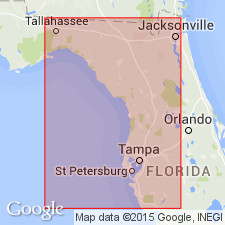
- Usage in publication:
-
- Hawthorn Group
- Modifications:
-
- Biostratigraphic dating
- AAPG geologic province:
-
- Florida platform
Summary:
Miocene land mammals are now known from five formations in the Hawthorn Group of northern peninsular FL and the eastern panhandle, including the Parachucla, Penney Farms, Torreya, Marks Head, and Statenville, and two Hawthorn formations in central FL, the Arcadia and Bone Valley. The upper Bone Valley Formation is the only unit in the group that is Pliocene in age. Age is based on occurrence of Palmetto Fauna in the upper pebble phosphate beds. (The Bone Valley Formation is equivalent to the Bone Valley Member of the Peace River Formation of Scott, 1988.) The Parachucla and the Arcadia Formations are Oligocene, in part, based on occurrence of White Springs and Cow House Slough Local Fauna within the units.
Source: GNU records (USGS DDS-6; Reston GNULEX).
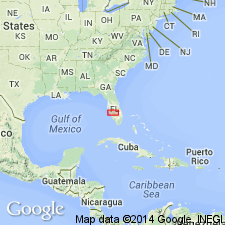
- Usage in publication:
-
- Hawthorn Group*
- Modifications:
-
- Age modified
- AAPG geologic province:
-
- Florida platform
Summary:
Hawthorn Group in the report area consists of (ascending) Arcadia Formation and its Tampa and Nocatee Members, and Peace River Formation and its Bone Valley Member (not differentiated in report). Nomenclature follows Scott (1988). Arcadia Formation is divided into lower undifferentiated part, Nocatee Member, Tampa Member, and upper undifferentiated part. Age of Arcadia is changed to early Oligocene to middle (and possibly younger) Miocene, based on mollusk and dinocyst data as well as 87Sr/86Sr age estimates. Age indicators in lower part are early to late Oligocene (30.3 to 26.8 Ma); age indicators for Nocatee are late Oligocene (27.1 to 26.3 Ma); age indicators for Tampa range from late Oligocene to middle Miocene (27.9 to 18.9 Ma); and age indicators for upper part range from late Oligocene to middle Miocene (28.6 to 16.7 Ma). 87Sr/86Sr data from mollusk very near top of Peace River Formation yields age estimate of 5.1 Ma (Pliocene). Age of Hawthorn Group in study area ranges from early Oligocene to Pliocene.
Source: GNU records (USGS DDS-6; Reston GNULEX).
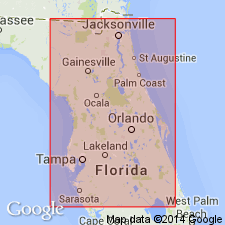
- Usage in publication:
-
- Hawthorn Group*
- Modifications:
-
- Age modified
- AAPG geologic province:
-
- Florida platform
Summary:
In southern FL, Hawthorn Group includes early Oligocene to early Miocene Arcadia Formation and middle Miocene to early Pliocene Peace River Formation. Age assignment of early Oligocene to early Pliocene is based on Sr isotope dates and dinocyst and mollusk assemblages.
Source: GNU records (USGS DDS-6; Reston GNULEX).
For more information, please contact Nancy Stamm, Geologic Names Committee Secretary.
Asterisk (*) indicates published by U.S. Geological Survey authors.
"No current usage" (†) implies that a name has been abandoned or has fallen into disuse. Former usage and, if known, replacement name given in parentheses ( ).
Slash (/) indicates name conflicts with nomenclatural guidelines (CSN, 1933; ACSN, 1961, 1970; NACSN, 1983, 2005, 2021). May be explained within brackets ([ ]).

